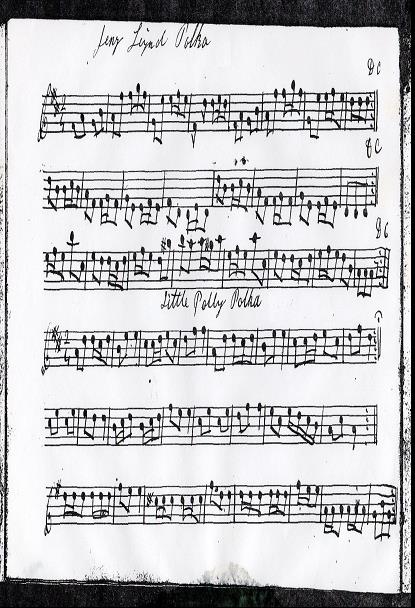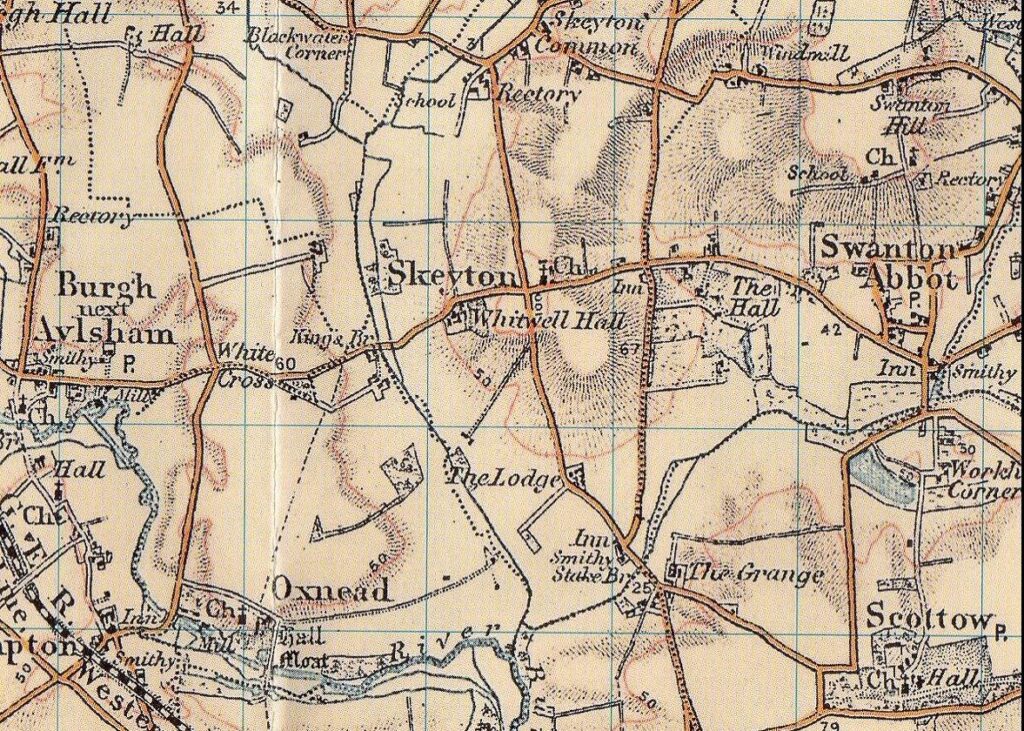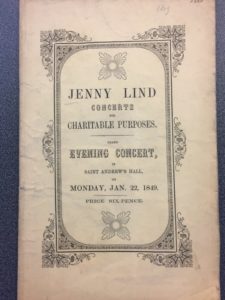
Page of the manuscript –
Jenny Lind and Little Polly Polkas
(more on this towards the end of this article)
The Village Music Project (VMP) – background
It is thanks to the Village Music Project (founded by Johnny Adams and Chris Partington and funded by the University of Salford) which began in 1998, that this Swanton Abbott tune book compiled by George Watson in the late 19th century has come to light.
The researchers now know of over 300 manuscripts some of which are on the VMP website, which were transcribed by a number of volunteers and put into ABC notation with an optional PDF version with introductions about the tune books where known.
For further details about this vast project use the following links:
Village Music Project
John Adams
Chris Partington
Richard Robinson Tune book
Folkopedia
In the introduction to the George Watson Tune book on the VMP website, we learn that following the launch of the VMP, George Frampton put an advert in the Journal of Kent History appealing for fiddlers’ tune books and as a result was gifted this tune book from Mr Victor Bowden of Kemsing, near Sevenoaks, Kent. Victor wasn’t sure how he came to have it in his possession – perhaps via a jumble sale he suggested…*
Whilst this article and our inclusion of the tunes from this tune book to some extent duplicates the fantastic work of the Village Music Project (VMP) Team, we have also added a slow(ish) audio clip of each tune for players who learn by ear as well as including a downloadable PDF from Alan’s transcriptions.
Taz Tarry transcribed the tunes from The George Watson manuscript for the project and as mentioned above, they are accessible in ABC format or via a pdf. EATMT volunteer Alan Helsdon took advantage of the copy of this manuscript which is now in the Norfolk Record Office as a result of the VMP. Some transcriptions will be similar to Taz’s and others Alan has adjusted in different keys to Taz’s chosen keys. Alan’s introduction below goes into further detail about this.
Introduction by Alan Helsdon
This set of tunes is intended for players, not scholars. The idea of helping these tunes to be played again, on whatever instrument, after all these years is immensely appealing. I have not hesitated to change the keys, correct presumed errors and even changed a few suspect notes in order to make the tunes playable. There are lots of mistakes in the MS and certainly some here (alan@quanting.co.uk if you find any please).
There were several un-named tunes in the book. Watson’s Quickstep, Watson’s Hornpipe, Swanton Abbott Hornpipe, Coltishall Hornpipe and Victor Bowden’s Hornpipe are all names which I have retained from the Village Music website.
Even then some of the tunes still had no names, so I have provided them from my researches or the map rather than call them Polka No 1 etc: Richard’s Polka, Mary‘s Polka (named after George’s father and mother), Perch Lake Polka, Scottow Schottische and Skeyton Galop (named after places nearby) are all my new names.
The pattern of A’s, B’s and C’s is not always simple. Unlike the majority of better known tunes, most of these change key for the B (and C) music and as a result don’t sound finished if you end the set there. Ideally if a B or C music is in a different key it should be followed by another tune or the A music again. I’ve made suggestions with each tune, but it’s up to the player(s) to decide what sounds right.
I thought hard about keeping some of the less ‘folky’ keys used like F and Bb but at the risk of being too bland I’ve stuck to the usual favourites of C, G and D. Original keys are shown. I have retained all bowing marks and occasionally added them.
I’ve not included any chords. These tunes can usually be harmonised with the usual selection of three or four per tune, though the non folky origins of some of the melodies imply slightly more adventurous harmonies than the average session group or Ceilidh Band attempts. A tune can be made vastly more interesting with different ones, so have a go! Melodeons have their own rules when it comes to this sort of thing anyway.
George Henry Watson
There is no indication that the George Henry Watson outlined below had any musical ability, but he fits the places and times and so is my most likely candidate for the owner of the book and probably the originator too. My research matches much of what is stated on the VMP introduction about George Watson and his tune book. I have researched further and a little more on George is included below.
George was born in 1859 and baptised at Skeyton Parish Church on July 3rd, son of Richard, labourer (born in Felmingham) and Mary Watson, both of Skeyton (see map below). His grandfathers were a labourer and a tailor. He had 7 brothers and 5 sisters born between 1854 and 1878.
He can be found at home on School Lane, Skeyton on the 1861, 1871 (where at the age of 12 he was listed as an agricultural worker) and 1881 censuses, on the last described as an Odd Ware Maker, aged 22, still living in Skeyton.
In 1883, he married Mary Knights in Swanton Abbott where Mary lived. It wasn’t until the 1891 census that we learn that they were living on West Skeyton Road, Swanton Abbott with sons Ernest George (aged 7 and born in Skeyton, December 1883), and Willie-Joseph (aged 3, born Swanton Abbott in 1887). Both boys were baptised in Skeyton. By now George had become a brickmaker.
By 1901 the family had moved to Cromer Road in North Walsham, so the appellation of ‘Swanton Abbott Tune Book’ seems to have been given before that.
In 1911 he and Mary are still on Cromer Road, the address being Fern Cottage. They are with both sons, Ernest and Willie, still in their twenties and single, and there are a couple of lodgers as well.
Regarding the two sons, Willie, aged 30, may have married Stella Pegnall in 1913, and Ernest may have wed Dorothy Blackburn in 1929 though he would then have been 45 years old. The death of an Ernest G Watson is recorded in Norwich District in 1955, aged 71.
At 84 years of age a George H Watson died in North Walsham District in 1944. He is likely to have been the book’s owner.
(From 1875 to 1891 a William Watson was landlord at the Black Horse, Skeyton, closed now, but still there, on Black Horse Road (norfolkpubs.co.uk) but I’ve not found a family connection).
The Map
This map is Copyright Cassini Publishing Ltd, and this extract is reproduced by kind permission.

Above is a detail from the map Norwich and the Broads 1901-2 and School Lane is indicated by ‘School’ top centre.
The Black Horse is marked as Inn and the parish church by the usual symbol, both just to the right of the central name ‘Skeyton’. The parish boundary (black dots) between Skeyton and Swanton Abbott runs north-south along Black Horse Road where the pub is. West Skeyton Road, Swanton Abbott (1891), now called Aylsham Road, is likely to have been the stretch between Black Horse Road and Swanton Abbott village, changing its name, as many roads do, at the boundary. The villages lie approximately 2 miles from each other and North Walsham is 10 miles further North East from Swanton Abbott.
The Tune Book
As a result of the found tune book, copies of the original lie in the Norfolk Record Office, the Vaughan Williams Memorial Library, The Village Music Project and also with the parish of Swanton Abbott.
On describing the original book, George Frampton writes for the Village Music Project: “This book comprises an undated manuscript book measuring 25 x 15.5 cm. whose corners and spine are leather bound…the work is ascribed on the inside cover pages to G.H. Watson, Swanton Abbott…There are 192 pages but the author has sectioned the book into polkas, galops, waltzes, schottisches and hornpipes (dotted and undotted)…separated by as many as 35 blank pages in between each part†(Village Music Project – George Watson introduction).
Though the tune book is undated, from the tunes, the researchers on the VMP were able to date the manuscript to at the earliest, 1880, based on the inclusion of tunes that are known to have not existed until then – Chris Partington mentions specifically the Hollyhock Schottische which was composed by Edmund Forman in 1880. This assumption makes sense knowing when George Watson actually moved to the village of Swanton Abbott, having been born in Skeyton and lived there until the 1880s. Though there are several tunes from the 18th century, there are also many popular tunes from the late 19th century. The tune “Soldiers of the Queen†is the chorus from the original march composed by Leslie Stuart which was initially composed for the opening of the Manchester Ship Canal in 1894. In 1895 lyrics were added and it was incorporated into the musical comedy “An Artist’s Modelâ€.
George Watson’s tune book gets a specific mention on the main manuscripts page of the VMP. Having collected copies of numerous tune books which span 150 years, it makes for a fascinating history on the development of social dances. The George Watson tune book is mentioned for his “brisk polkas†and “ballroom variants of the schottische†– two dance forms that came into their own mid 19th century.
A manuscript page
Just one page to give you an idea of what the book looked like. Here are Jenny Lind Polka, and Little Polly Polka.

In the former tune above (Jenny Lind polka) the letters DC at the ends of the unlabelled A, B and C sections on the first 3 staves stand for da capo, Italian for ‘the head’, or, in a musical context ‘from the top’, indicating that the A section is to be played between B and C, and after C. The third section is alas not usually played today but I have given it in G as well as A to encourage its re-introduction.
In my experience the most common version of Jenny Lind played today is that of Walter Bulwer and the other musicians on the English Country Music LP.
Jenny Lind

O. Södermark
Chris Partington in his introduction to this tune book on his website notes the inclusion of this original three part polka (composed by Anton Wallerstein around 1850). Jenny Lind was an opera singer (also known as the Swedish Nightingale) ‘who took London by storm in 1847’.
She continued to perform across the UK for the next two years including travelling three times to Norwich to perform. Performing twice in 1847 in Norwich, her arrival “was marked by crowds lining the streets, church bells ringing and gun salutes. Her welcome by the city was remembered as she returned only two years later with the distinct purpose of performing here for charityâ€. Returning a third time in January 1849, she stayed with Bishop Stanley and performed on the 22nd and 23rd January at St Andrew’s Hall.

Source Norfolk & Norwich
University Hospital
The money raised from these two concerts was put towards the building of an infirmary for sick children which was opened in Pottergate in 1954 thus becoming, after London’s Great Ormond Street Hospital, the second city in the UK to establish a children’s hospital. Writing to the chair of the hospital committee, Jenny Lind wrote “Of all the money which God allowed me to give away when my poor throat could call an audience to listen to its production, none has borne a more nobler fruit than the Jenny Lind Hospital of Norwich.†You can read more about the history of the hospital which is now based on the Colney Lane in Norwich here.
A children’s play park was created, also in Pottergate, which commemorated Jenny Lind’s name, and in the late 1920s and 1930s Alan’s mother, being the eldest girl in a large family, used to take assorted siblings to play there. This park has now moved to Vauxhall Street and the original decorative gate has been re-erected there.
Later in 1849, Jenny Lind was approached by the great showman P T Barnum and she travelled to America in 1850 where she performed over 90 concerts for him.
Alan Helsdon
Alex Bartholomew
November 2020
*Whilst double checking dates for Watsons in Swanton Abbott and North Walsham, as we neared the completion of the transcribing and recording of the tunes, Alan also found the death of a Victor Bowden in 1993 of North Walsham. Coincidence that the name of the donator of this tune book was a Victor Bowden? They are different Victor Bowdens (the donator being from Kent in 1998) but it is something we are now digging into just to satisfy our curiosity. We will update this page if we find further interest to report on.
The Tunes
The tunes found within the George Watson tune book below are in alphabetical order but with each one bracketed with the VMP tune reference number (prefixed by GHW). Each tune has a downloadable pdf of the tunes often transcribed by Alan into “folk friendly†keys and also a slower tune version mp3 track for musicians who prefer to learn by ear. The suggested A/B/C order of play is found on the pdf.
(The file size is too large to allow the whole of this tune on one mp3 or wav file)
Alan Helsdon conducted the additional research into this tune book for this article – a copy of which can be found in the Norfolk Record Office.
The tune book came to light during the Village Music Project in 1998 where further information can be found.
More information about Jenny Lind and her links with the Norwich children’s hospital is found on the website of the Norfolk & Norwich University Hospital Trust.